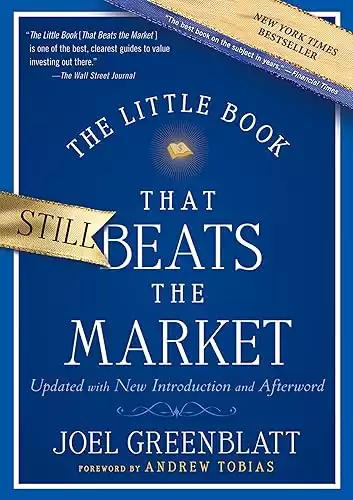Overview : The Little Book That Still Beats the Market
-
Book Title: The Little Book That Still Beats the Market
-
Author: Joel Greenblatt
-
Publication Date: October 2010 (Revised Edition)
-
Rating: 4.5
-
price: $15.69
-
Pages: 208
About the Author
Joel Greenblatt, a renowned investor and professor, authored The Little Book That Still Beats the Market. In this book, Greenblatt simplifies complex investment strategies, introducing the "Magic Formula" to help individual investors achieve market-beating returns through value investing.
Introduction to The Little Book That Still Beats the Market
In the ever-evolving world of finance and investing, Joel Greenblatt's "The Little Book That Still Beats the Market" stands out as a beacon of simplicity and effectiveness. This concise yet powerful guide offers a fresh perspective on value investing, making it an essential read for both novice investors and seasoned market veterans.
The Little Book That Still Beats the Market Book Summary
At the heart of Greenblatt's book lies the "Magic Formula," a straightforward investment strategy designed to identify undervalued companies with high earnings yields and substantial returns on capital. This approach aims to minimize risk while maximizing returns, offering a systematic way for investors to consistently outperform the market.
"The secret to investing is to figure out the value of something – and then pay a lot less." - Joel Greenblatt
Greenblatt's formula focuses on two key criteria:
- High earnings yield
- High return on capital
By prioritizing these metrics, investors can identify "good companies at bargain prices," creating a portfolio with strong potential for long-term growth.
Analysis of Themes: Long-Term Thinking and Value Investing
The Power of Patience
A recurring theme in Greenblatt's work is the importance of long-term thinking in investing. He emphasizes that successful investing is not about making quick profits but about compounding returns over time. This aligns with Warren Buffett's famous quote, "The stock market is a device for transferring money from the impatient to the patient."
Value Investing in the Modern Era
Greenblatt's Magic Formula is a contemporary take on value investing, a strategy popularized by Benjamin Graham and Warren Buffett. In today's fast-paced market, where cryptocurrencies and tech stocks often dominate headlines, Greenblatt's approach serves as a reminder that fundamental analysis and patience still have a place in successful investing.
Writing Style: Accessible and Engaging
One of the book's greatest strengths is Greenblatt's ability to convey complex financial concepts in a conversational and often humorous tone. He uses relatable anecdotes and real-world examples to illustrate the mechanics of the Magic Formula, ensuring that the content is both informative and enjoyable to read.
"Value investing is simple to understand but difficult to implement." - Joel Greenblatt
The book's structure builds knowledge progressively, starting with foundational concepts before introducing the Magic Formula. This step-by-step approach ensures readers have a solid understanding of the principles and are equipped to apply them independently.
Strengths and Weaknesses: A Balanced Perspective
Strengths:
- Simplicity and accessibility of the Magic Formula
- Practical guidance on implementation
- Focus on long-term investing principles
- Engaging writing style
Weaknesses:
- May not account for all variables affecting stock performance
- Reliance on historical data might not always predict future outcomes
- Limited discussion of broader market trends and macroeconomic factors
Related Books of The Little Book That Still Beats the Market
Greenblatt's book shares similarities with other value investing classics like Benjamin Graham's "The Intelligent Investor" and Peter Lynch's "One Up On Wall Street." However, "The Little Book That Still Beats the Market" distinguishes itself through its simplified approach and focus on a specific formula.
Compared to more recent works like "A Random Walk Down Wall Street" by Burton Malkiel, which advocates for passive investing, Greenblatt's book offers a middle ground. It provides a systematic approach to active investing while maintaining simplicity and accessibility.
Highlights from The Little Book That Still Beats the Market by Joel Greenblatt
Simple Investing Formula: Greenblatt introduces a "Magic Formula" that ranks stocks based on earnings yield and return on capital.
Value and Quality Focus: The formula identifies high-quality companies at low prices, targeting undervalued stocks with strong profitability.
Long-Term Perspective: Encourages patience, as the formula may outperform over time but can face short-term setbacks.
Consistent Application: Emphasizes sticking to the formula consistently, regardless of market fluctuations or emotions.
DIY Investment Approach: Designed for individual investors, the book empowers readers to implement the strategy without relying on complex analysis.
Market Beating Potential: Proven formula has outperformed traditional market returns in the long run.
Conclusion: A Timeless Guide for the Modern Investor
"The Little Book That Still Beats the Market" is an insightful, approachable, and practical guide that challenges conventional wisdom in investing. Joel Greenblatt's Magic Formula offers a simple yet powerful strategy that empowers investors to navigate the complexities of the stock market with confidence.
While no strategy is without limitations, the principles outlined in this book provide a solid foundation for anyone looking to enhance their understanding of investing and improve their financial outcomes. By focusing on long-term value and maintaining discipline, readers can harness the power of the Magic Formula to achieve lasting success in the ever-evolving world of finance.
In an era of rapid technological change and market volatility, Greenblatt's timeless wisdom serves as a reminder that sound investment principles never go out of style. Whether you're a beginner looking to start your investment journey or an experienced investor seeking to refine your strategy, "The Little Book That Still Beats the Market" offers valuable insights that can help you navigate the complex world of personal finance and investing.





